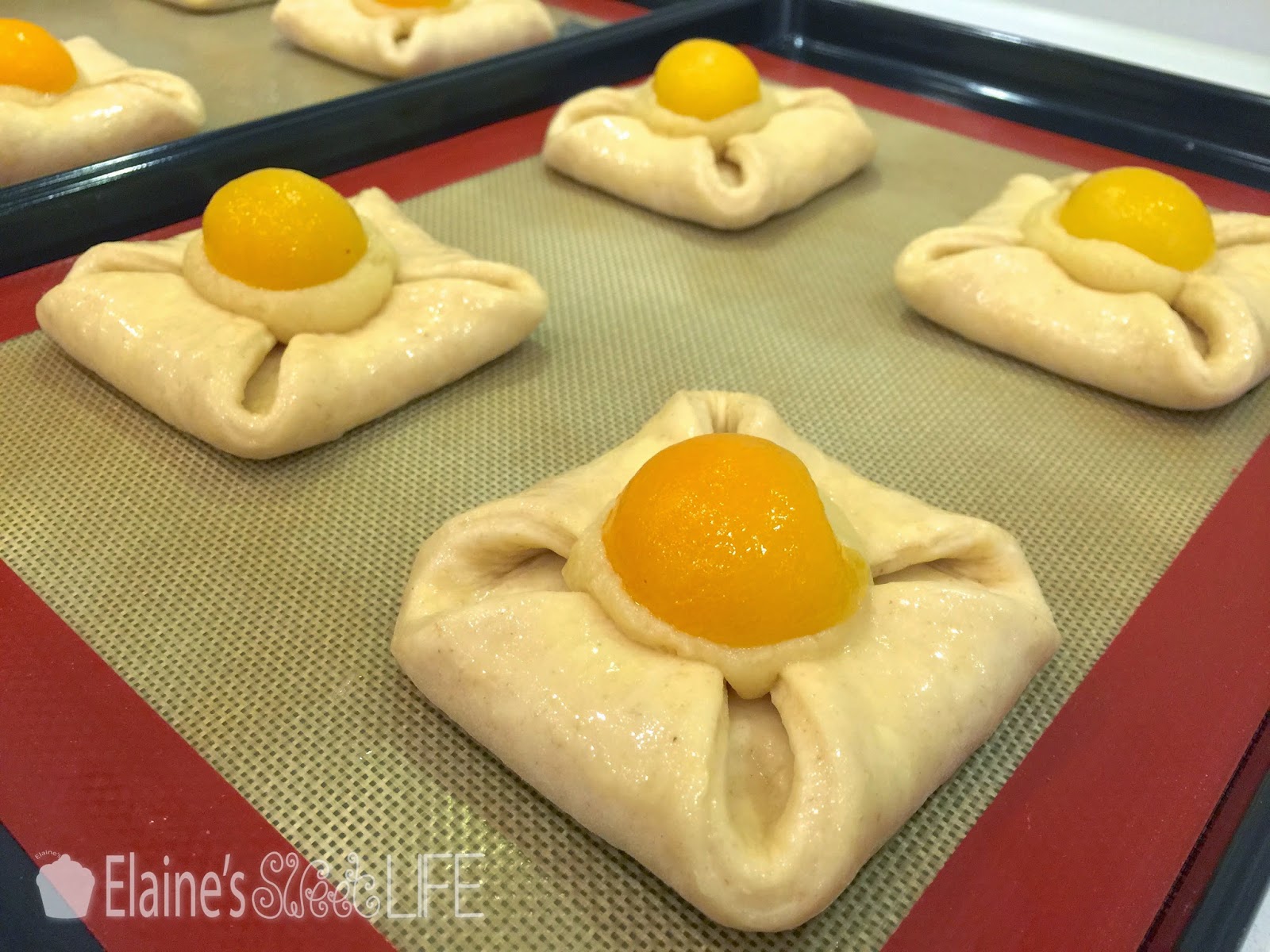We had such a lovely Valentines Day. Not only did I get a dozen red roses from mu hubby, but he took me out, twice! Granted, lunch was only hamburgers, but he took me to Five Guys, who are reputed to have amazing burgers and chips, and they were pretty good. In the evening we went to a place called Banana Tree, serving Indochina regional style food. The food was amazing! We also took our Youth to a Valentines Dance, and my man and I got a few 'slow dances' in - the kids thought it was very cute ;)
Amongst all the busyness of the day, I made delicious Danishes for my family. While these are quite time consuming, they are not actually that difficult to make, and don't take all that much effort either. Most of the time consumed is in waiting for the dough to chill, rest and rise - and you can go off and do other things in that time. The smiles on the faces of your loved ones as the irresistible aroma of freshly baked goods draws them to the kitchen is all worth it!
Apricot Anglaise Danish PRINT
Makes 8
The pastry dough needs to be prepared the day before baking.
Ingredients:
Pastry:
125 g bread flour
125 g all purpose flour
7 g instant yeast
30 g golden caster sugar
1/2 tsp salt
120 g unsalted butter - chilled
100 g unsalted butter - frozen
80 ml milk - room temperature
40 ml water - room temperature
1 egg
Custard:
250 ml milk
1 tsp vanilla
1 large egg
2 large egg yolks
100g caster sugar
25g cornflour
8 canned apricot halves
50g smooth apricot jam
Method:
Pastry Dough:
Put the flours, yeast, caster sugar and salt in a food processor and blend together. Cut the chilled butter into 1 cm cubes. Add to the dry ingredients in the blender. Pulse blend until the butter becomes combined with the dry ingredients, but the butter it is still visibly lumpy (these lumps contribute to the flakiness of the pastry).
Tip into a mixing bowl.
Pour milk and water over the flour/butter mixture. Fold it together until you get a very rough dough - the butter lumps should still be there. Tip out onto counter top and briefly knead into a ball of dough, then shape into a flat rectangle, wrap in clingfilm and refrigerate for 45 minutes.
Once chilled, roll the dough out (on a lightly floured counter) into a rectangle about 50cm long. Grate the frozen butter and spread it over the bottom 2 thirds of the dough. Fold the top third of dough down over the butter, then fold the bottom third (with butter on it) up over that again (like folding a letter into thirds).
Wrap in clingfilm and refrigerate for 30 minutes.
Roll the dough out to a rectangle about 50cm long. Fold the top third down and the bottom third up.
Repeat the 'roll-and-fold' twice more.
Wrap the dough in clingfilm and chill overnight.
Custard:
The Custard can also be prepared the day before.
Pour the milk and vanilla into a saucepan and bring to the boil.
Mix the eggs, caster sugar and cornflour in a heatproof bowl / jug, to a smooth paste. Pour the boiling milk into the egg mixture while stirring, mix well. Pour the mixture back into saucepan and return to a medium heat, stirring constantly. Once the mixture begins to thicken, stir vigorously with a whisk. Allow the mixture to come to the boil and cook for 2 minutes (to cook out the raw cornflour flavour) while stirring. The custard should be very thick.
Place the custard into a bowl and cover with cling film, pressed to the surface of the custard. Allow to cool completely. Refrigerate if making it the day before.
Shape, prove, fill and bake:
Roll the dough out to a 25 x 50 cm rectangle.
Trim the edges straight, then cut into eight squares (each should be just smaller than 12 x 12 cm).
Fold the four corners into the centre of each piece and press to secure in place.
Cover loosely with clingfilm and leave to prove for 2-3 hours.
Once proved the pastries should look nice and puffy.
Preheat the oven to 200ºC (180ºC fan forced),
Get the custard into a piping bag.
Pipe a large round into the middle of each pastry. Place half an apricot onto each round of custard (cut side down).
Beat the egg and brush onto the exposed pastry.
Bake for 20-25 minutes until nicely browned.
Allow to cool for a few minutes on the baking tray, then transfer to wire racks to cool completely.
Boil the apricot jam to get it really runny, then brush over the entire top of the pastries to glaze.
Happy Baking!

























Nice
ReplyDelete